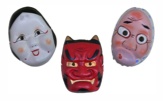More Japanese
KIMONO (着物)

Japanese style garment.
This is the traditional Japanese garment made of silk or cotton. Some expensive ones could run into more than $10,000. Worn according to the seasons and occasions. For example the “Yukata” is a representative casual kimono for summer use.
OBI (帯)

Sash
A long wide sash used to tie around the kimonon. Usually for elaborate kimono, one uses a rather subtle obi, whereas for less elaborate kimono, one will use a showy type of obi. With these combinations, the obi can change an image and become a vital part of fashion.
OBIJIME (帯締め)

The obi closure
This is the string used to keep the obi closed. It acts as an accent for the kimono, and depending upon what one wears, by the season and occasions, one can selectively use an obijime.
ZOHRI (草履)

Japanese style footwear
The slipper to go with kimono. When one does not wear a tabi (heavy socks-like footwear), then usually a wooden clog is worn.
KANZASHI (簪)

Japanese style hair pin
This is a woman’s hair accessory. It can be made of wood or gold, silver, glass, tortoiseshell, precious stones and other materials. There are those with designs of gems, flowers, or flashy objects.
OHGI / SENSU (扇・扇子)

Fans, folding type
The sensu is used for fanning oneself, while there are fancy fans used to accompany dancing. These are also used for ceremonial events or in classical dances.
UCHIWA (団扇)

Fans
A fan primarily used for fanning during summer, for casual attire.
KATANA (刀)

Sword
One type of a samurai’s weapon. From ancient days, it has also been an object for artistic craftsmanship.
KABUTO (兜)

A samurai’s helmet
One of the protective headgear that samurai wore during battle.
FUROSHIKI (風呂敷)

A wrapping cloth
A square piece of cloth Japanese use to wrap and carry things.
Some of them are as large as 2.5 meters in width.
NOREN ( 暖簾)

An entry door curtain
A piece of cloth (some are divided) that is hung at the door to protect one from sun light or to use as a privacy shield. It could be used to divide the sections in a hallway or room.
MANEKI-NEKO (招き猫)

The “inviting” cat
A cat figurine which usually has one upraised hand that gives a sign to invite someone in. As a good luck symbol to invite customers or wealth into the house, it is now commonly used as a decorative piece at a merchant’s store entrance.
DARUMA (だるま)

The Dharma figurine
A figurine wearing a red garment, and without any hands or legs.
There are many variations. those without the eyes painted in are used for “make a wish” occasions. When you wish something, you paint his left eye, and when that wish is fulfilled, one paints in the right eye.
The figurine is weighted at the bottom and thus can upright itself when pushed down. Because of this up righting ability, it is often considered as a good luck piece for business opening.
KOMA (独楽)

Top
One of the traditional toys. There are numerous ways to spin it and to play with it. It has been used for entertainment tricks.
TEMARI (手毬)

A girl’s ball
A toy ball made of cotton threads.
Some can make sounds, some have variety of colored silk threads, and can be used as decorations.
OMEN (お面)

Mask
A toy made to resemble a man’s mask. Can come in various types of facial expressions, and some are used in traditional drama and art performances, of used as a decorative piece.
OSHOHGATSU (お正月)

New Years
The most traditional Japanese holiday that begins the year. It lasts for three days. Usually many businesses close from the previous year-end. A special New Year’s dinner, called “o-sechi”, is prepared, and is enjoyed together with Japanese sake. For those interested in this “o-sechi” cuisine, please contact Sushi Luck.
SETSUBUN (節分)

The changing day from winter to spring
This is usually around the 3rd to 4th of February, during which the traditional ritual of “ousting the bad devil” and “inviting in the good fortune” practices are acted out. This involves throwing out roasted soybeans in and around the house then one picks them up and eats the number of soybeans of his/her age.
HINA-MATSURI (ひな祭り)

The Doll Festival
This is a traditional girl’s festival that takes place on March 3rd. At homes where there are girls, they pray for happiness and peaceful growth, and display elaborate doll sets complete with all its accompanying furniture and accessories.
KOI-NOBORI (鯉のぼり)

The carp windsocks
A traditional decoration for boy’s day on May 5th. At homes where there are boys, they pray for health growth and successful career. Inside the house they would decorate with armor, helmets, swords, samurai warrior figures. Outside, they will raise a pole with the symbolistic carp windsocks.
TANABATA (七夕)

The romantic summer festival
An event that takes place on July 7th. One writes various wishes onto colored strips of paper, and together with other decorative ornaments, hang them onto bamboo trees.
